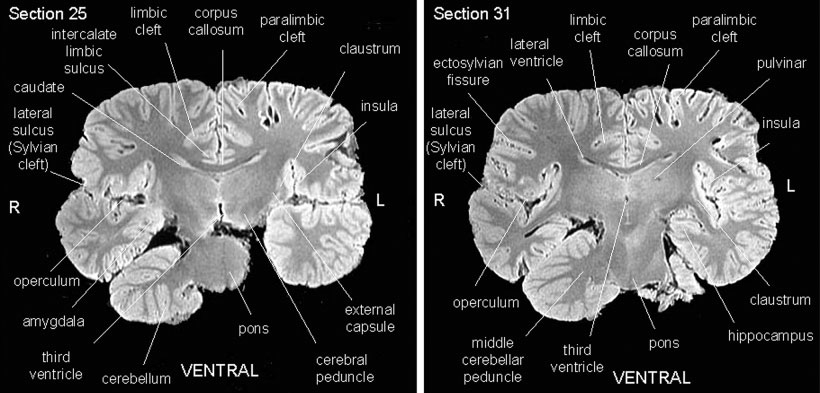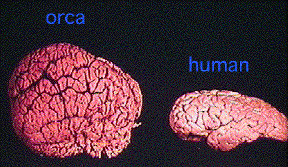What makes humans so special? Is it their ability to use language and empathize with others? Their ingenuity? Their tool making? It has been known for some time that other non-human primates are avid tool users, too. Yet it does not stop there – a plethora of other species including birds, invertebrates, rodents etc. have also been found to use tools specialized to their environments and needs. It’s also been made clear that, though our language has a highly developed level of syntax and grammar, other species do have lingual forms of their own. These are only a few of the many attributes once thought to be merely human that have been recognized, in their own forms, in species around the world.

Figure 1. This MRI coronal section image was taken midway through a developed, postmortem killer whale’s brain. Of particular note are the enlarged limbic lobes on the medial surface of both hemispheres above the corpus callosum on the dorsal aspect of the brain. (Citation 1)
The species of topic today is one who has demonstrated many human-like qualities including intelligence, language, and an exquisite sense of emotional capability: Orcinus orca , the killer whale. These massive toothed whales are home in the cold waters of the North Atlantic, North Pacific, and Antarctic but dwell in vast expanses around these areas, sometimes swimming hundreds of miles a day. The largest killer whale ever found stretched up to about 10 meters and weighed about 10 tons. However, not only are their bodies massive; so too are their brains. Postmortem MRI studies of the killer whale brain have shown that it is on the scale of 3.5-6.5 times as massive as a common bottlenose dolphin, another cetacean species that has demonstrated non-human-person-like qualities [1] . Their brain also demonstrates an exquisite level of cortical folding similar to humans and other higher mammals (chimpanzees, but not macaques, for example), which indicates high amounts of cortical processing, as seen in Figure 1.

This image depicts the relative size difference of post-mortem Killer Whale and human brains. (Citation 6)
Three areas of particular interest stand out when observing intact killer whale brains that are enlarged with respect to human brains: the insular cortex, its surrounding operculum, and the limbic lobe. First, the frontal operculum is correlated with speech in humans, while the insular cortex is involved with audition, or the ability to hear and process sound. These areas reside on the upper surface of the temporal cortex. It has also been hypothesized that a part of the operculum in killer whales innervates the nasal respiratory tract, the origin of killer whale vocalization [2] . As such, it has been speculated that this area serves similar functions as the speech-related operculum in humans. Indeed, the vocal patterns found within orca pods demonstrate levels of communication beyond mere sounds. Similarly, the structural differences of sound patterns between different orca pods is suggestive of dialectical variation as well as the fact that sound may be a learned behavioral trait used for communication [3] .
The third structure of particular importance is the enlarged limbic lobe, located on the medial surface between the two hemispheres, directly above the corpus callosum. In humans, the limbic system is associated with emotional life and behavior as well as the formation of memories. Humans only have one cingulate gyrus, located medial above the corpus callosum, associated with the limbic system. Orcas’ cingulate gyrus, or limbic lobe, on the other hand is vastly enlarged and made up of three separate lobes separated by two clefts: the limbic and paralimbic clefts, as seen in Figure 1. Beyond the enlargement of these areas, the cellular architecture also gives clues to the extent of their aptitude for emotional expression. Spindle cells, associated with the limbic system processing of social organization and empathy, were once thought to be unique to the great apes but have since been found in whale species including orcas. In fact the relative number of spindle cells in killer whales is larger than that of even the human brain [4] !
Killer whales’ demonstration of extremely coordinated group behavior and social interaction including both vocal and non-vocal cues arguably correlates with this vast expanse of the cortical areas mentioned above [5] . It certainly is true that upon observing killer whales, both in the wild and in captivity, that they exhibit a range of emotions from joy, fear, frustration, and anger, as well as self-awareness. As such, this generates a new set of ethical questions regarding the ways humans continue to interact with killer whales and other whale species by keeping them in captivity and killing them unnecessarily for food. As research continues, it might be time to reconsider the cognitive status of certain other life forms as non-human persons capable of intelligent inter- and intraspecies interactions.
If you want to learn more about the sad story of killer whales in captivity and the efforts being undertaken to free them check out the movie Blackfish (2013).
- Marino, L., Sherwood, C. C., Delman, B. N., Tang, C. Y., Naidich, T. P., & Hof, P. R. (January 01, 2004). Neuroanatomy of the killer whale (Orcinus orca) from magnetic resonance images. The Anatomical Record. Part A, Discoveries in Molecular, Cellular, and Evolutionary Biology, 281, 2, 1256-63. http://onlinelibrary.wiley.com/doi/10.1002/ar.a.20075/full
- Morgane PJ, Jacobs MS, MacFarland WL. 1980. The anatomy of the brain of the bottlenose dolphin ( Tursiops truncatus ): surface configurations of the telencephalon of the bottlenose dolphin with comparative anatomical observations in four other cetacean species. Brain Res Bull 5 (Suppl 3): 1–107. http://www.sciencedirect.com/science/article/pii/0361923080902725
- Deecke, V. B., Ford, J. K. B., & Spong, P. (November 01, 2000). Dialect change in resident killer whales: implications for vocal learning and cultural transmission. Animal Behaviour, 60, 5, 629-638. http://www.sciencedirect.com/science/article/pii/S0003347200914544
- Bekoff, M. (2007). The emotional lives of animals: A leading scientist explores animal joy, sorrow, and empathy–and why they matter . Novato, Calif: New World Library. http://books.google.com/books
- Marino, L., Connor, R. C., Fordyce, R. E., Herman, L. M., Hof, P. R., Lefebvre, L., Lusseau, D., … Whitehead, H. (May 01, 2007). Cetaceans Have Complex Brains for Complex Cognition. Plos Biology, 5, 5.) http://www.plosbiology.org/article/info%3Adoi%2F10.1371%2Fjournal.pbio.0050139
- Whiting, Candace C. “Orca Brains Are Large And Complex.” Seattlepi.com . SeattlePi, 13 July 2009. Web. 07 Dec. 2013. http://blog.seattlepi.com/candacewhiting/2009/07/13/orca-brains-are-large-and-complex/
